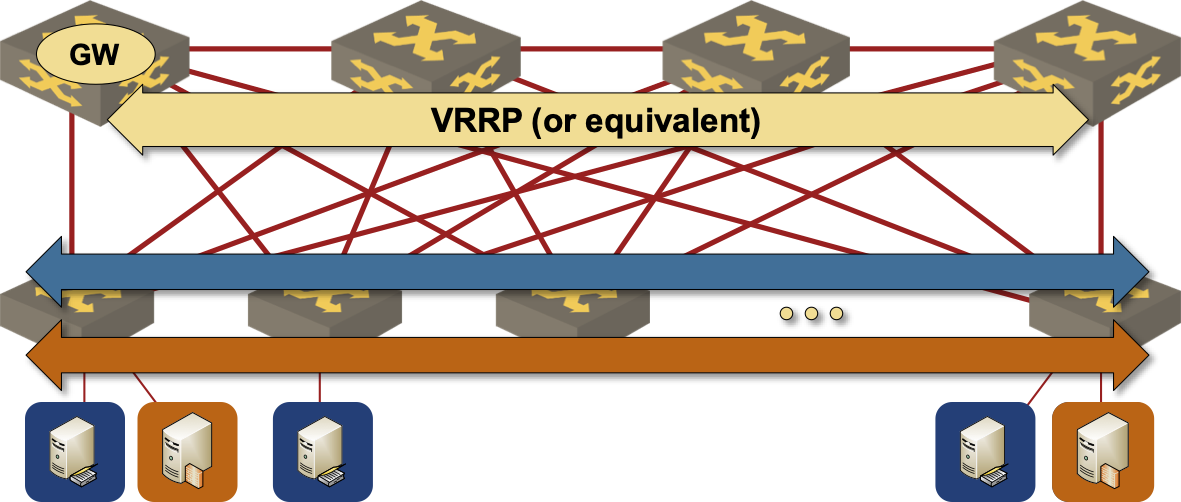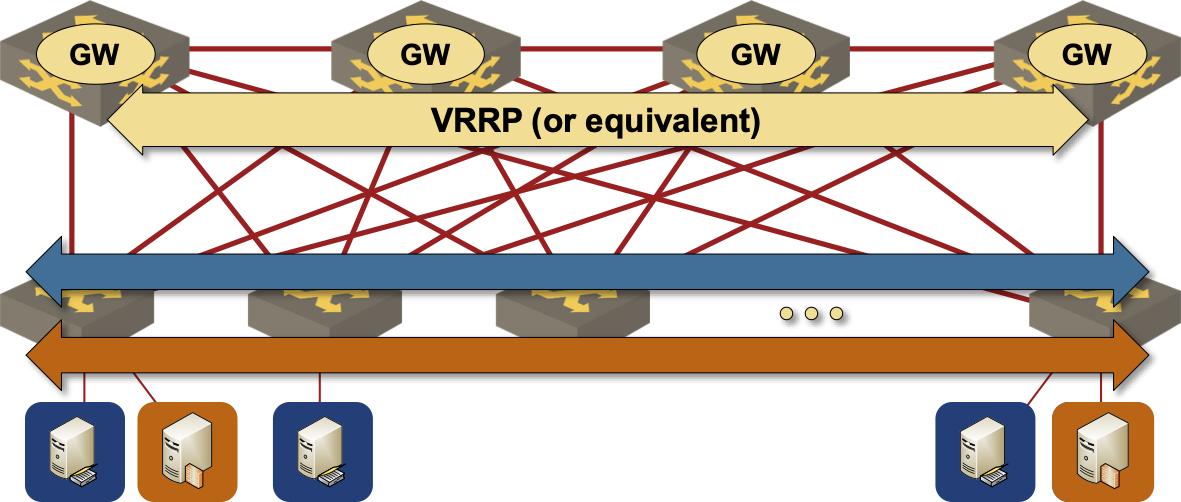Routing in Stretched VLAN Designs
One of my readers was “blessed” with the stretched VLANs requirement combined with the need for inter-VLAN routing and sub-par equipment from a vendor not exactly known for their data center switching products. Before going on, you might want to read his description of the challenge he’s facing and what I had to say about the idea of building stackable switches across multiple locations.
Here’s an overview diagram of what my reader was facing. The core switches in each location work as a single device (virtual chassis), and there’s MLAG between core and edge switches. The early 2000s just called and they were proud of the design (but to be honest, sometimes one has to work with the tools his boss bought, so…).

Overview diagram
To make it even more interesting, the whole network is a set of giant VLANs potentially stretching across all edge and core switches. Of course that makes it a single failure domain, but that’s the least of my reader’s worries.
When my reader wanted to implement inter-VLAN routing he faced the usual challenge: where should the first-hop router be? The “traditional” designs (remember: early 2000s are still on the line enjoying the show) would run some first-hop redundancy protocol between the two core switch clusters and select one of the clusters (or even one of the boxes within one of the clusters) as the active router:

Single core switch is an active router
Most networking vendors “discovered” years ago what the correct solution is: anycast gateway, either properly implemented (Arista and Enterasys had it years before anyone else) or faked with dirty tricks like HSRP filtering.

All core switches are active first-hop routers
The solution my reader implemented was something completely different: let’s stretch the virtual chassis across both data centers (ignoring that one data center will be dead if the DCI link ever fails)… because then the first packet (in a flow? between a pair of IP addresses?) would go through the master switch (that also acts like a router), but then the master switch would install a flow entry in all other switches, and the rest of the traffic would use that shortcut.

Stretched stackable switch with conversational learning
At that point, 1990s joined the call with fond memories of early Catalyst 5000 multi-layer switching implemented with a router sitting on top of that switch, or as RFC 1925 says…
Every old idea will be proposed again with a different name and a different presentation, regardless of whether it works.
Long story short:
- Try to avoid broken designs (VLANs stretched across multiple locations). There might be a better option; Building Active-Active Data Centers webinar has some more details.
- Figure out what problem you’re solving (inter-VLAN routing) and what’s the best way to solve it (anycast first-hop gateway). Our Leaf-and-Spine Fabrics webinar might help.
- Use the tools that solve the problem the right way. I know that’s impossible in some environments, but in that case it’s time to start polishing your resume. As Ethan Banks pointed out in a recent blog post, more organizations are amenable to remote work than ever.

Wow, I wasn't expecting a blog post for my use case... I'm not offended, I was expecting a kick in the ass :-D
I knew the choice was bad, but didn't knew how to make it work better. I'll lab it and see if we can still enhance the production network.
Thanks for your knowledge.
Dear Ivan, can you please elaborate on: "faked with dirty tricks like HSRP filtering" Thanks, m
@mrh: Imagine you have four core switches acting as routers. They run HSRP/VRRP/whatever, and only one of the becomes active forwarder. Not good, but not a big deal.
Now imagine you spread them across two data centers. "Not good" becomes "WTF" as all inter-VLAN traffic goes to the other side to be routed.
Enter the magic world of HSRP filtering: if you filter HSRP hello packets on the DCI link, the routers don't know someone else is using the same IP/MAC address on the other side.
Is this sane? Definitely not. Does it work? Sort-of. Is it promoted by a large networking vendor? You bet.
For more details just google for "HSRP filtering" 😊